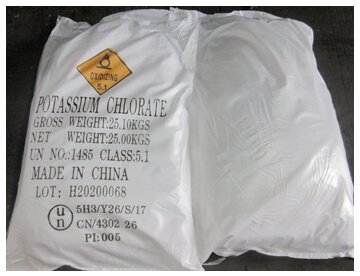Potassium Chlorate

Synonyms: Berthollet salt, Potassium Chlorate
We offer potassium Chlorate from a warehouse at the favorable prices with delivery throughout Russia.
| Purity | 99.5% min |
| Moisture content | 0.05% max |
| The content of water-insoluble substances | 0.02% max |
| The content of CL | 0.04% max |
| Sulphate | 0.01% max |
| Bromate content | 0.05% |
| Percentage of particles passing through the grid | 125 µm 99.5% min |
Description
Potassium chlorate, bertolet salt, KClO3
Molecular weight 122.55. Colorless crystal. Poorly soluble in water.
The table of Solubility in water at an appropriate temperature:
| T, °C | 0 | 10 | 20 | 30 | 40 | 50 | 60 | 80 | 100 |
| solubility, g / 100 g of water | 3,3 | 5,0 | 7,0 | 10,2 | 14,5 | 19,7 | 26,0 | 39,0 | 56,0 |
Not hygroscopic (hygroscopic point – 97.7%). The transition temperature from monoclinic to rhombic system 255°C, t sq. 356°C (according to other data, 368°C). Begins to decompose at 400°C to potassium perchlorate with the release of oxygen. The melt is explosive. Slowly decomposes under UV radiation to potassium chlorite, potassium chloride and oxygen. Flash point 467°C (5-sec. delay.) The heat of formation -398.2 kJ / mol. Heat capacity at 300K 829 j/(kg·K), thermal conductivity of 0.62 W/(m·K). Density 2.33 g / cm3.
Under the action of acids cleaves explosive chlorine dioxide, in the presence of which many organic materials self-ignite. One of the most active oxidizers in pyrotechnics. It has a low decomposition temperature, compositions based on it have low ignition temperatures. In its pure form can explode from a very strong impact, but does not detonate from the blasting cap No6.
Decomposition catalysts are manganese dioxide, potassium bichromate, copper oxides. It is not compatible with ammonium salts, since in the presence of moisture a low-stable ammonium chlorate is formed, which is prone to self-ignition (in the USA such compositions are prohibited by law). In a mixture with phosphorus in a dry form explodes even with minimal compression. It is not recommended to use potassium chlorate together with metals such as magnesium and aluminum because of the high sensitivity and activity of such mixtures. It is impossible to allow rubbing of structures on its basis in a dry kind. Care should be taken when mixing with sulfur-containing substances. Was first obtained in 1786 Bertolli
Potassium chlorate is obtained by electrolysis of a solution of potassium chloride on coal electrodes in the presence of potassium bichromate; chlorination of a heated aqueous solution of slaked lime. The resulting calcium chlorate is drained with a solution of potassium chloride, after which the crystals of potassium chlorate fall out.
Toxic. Lethal dose for humans over 50 mg / kg.
Usage
Potassium chlorate is used for the production of matches, fireworks, explosives, dyes, solution as an antiseptic in medicine.
Used in pyrotechnics: from the mid-19th century is used as the oxidant signal compositions in the civilian pyrotechnics, in the shock trains. Many potassium chlorate compounds are sensitive to friction and impact. Mixtures containing crude sulfur or acid impurities are prone to self-ignition, so compounds with potassium chlorate often contain substances that neutralize acid, such as chalk. At present, the application of potassium chlorate is limited to compositions of colored smoke, matches and scratch compositions.

